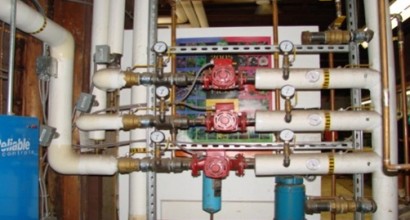This section illustrates examples of some mechanical insulation issues from the field.

Detail showing rubber insulation on a hot gas refrigerant line. The insulation should be jacketed to protect it from sun and birds.
Problems with insulation are not limited to whether there is insulation installed or not. Sometimes designers or contractors have made poor choices or have not adequately protected the insulation from environmental damage. This preceding photo gives an example of rubber closed cell foam insulation that has been attacked by birds. At the time this photo was taken, the insulation was less than one year old. When installed properly, this kind of insulation would have a PVC jacket which prevents damage from pests and from the ultraviolet rays from the sun, extending the insulation service life.

Detail showing heat exchangers used with domestic water system approximately 12 years old
It is common to see condensation on un-insulated sections of domestic water piping and fittings. Generally fittings are made of brass or stainless steel and these are not affected by some condensation; however, there will be an increased heat transfer rate due to condensation. Where carbon steel piping or fittings are used, the affects of condensation may be more serious. Also, condensation can damage building elements such as drywall, ceiling tile and concrete below dripping pipes. On this image, note the build up of deposits on the heat exchangers.

Detail showing corrosion damage to pipe fittings as the result of condensation
Where carbon steel piping or fittings are used, the affects of condensation may be more serious. Also, condensation can damage building elements such as drywall, ceiling tile and concrete below dripping pipes.

Detail showing backflow preventer on domestic water supply line. Note the water dripping from the device.
It is common to see condensation on un-insulated sections of domestic water piping and fittings. This photo shows condensation on a backflow preventer. Generally fittings are made of brass or stainless steel and these are not affected by some condensation; however, there will be an increased heat transfer rate due to condensation.

Detail showing un-insulated hydronic distribution system and heat exchanger for domestic hot water system
However, it is common to not see insulation in mechanical rooms and on pipe and duct runs through buildings. Energy is often wasted by transfer into unheated areas that don’t need any heat (e.g. mechanical rooms) or pipe chases.

Detail showing circulation pumps on a hydronic distribution system
When installed properly, the service life of the insulation will usually match the service life of the piping, ducts or equipment it is installed on.